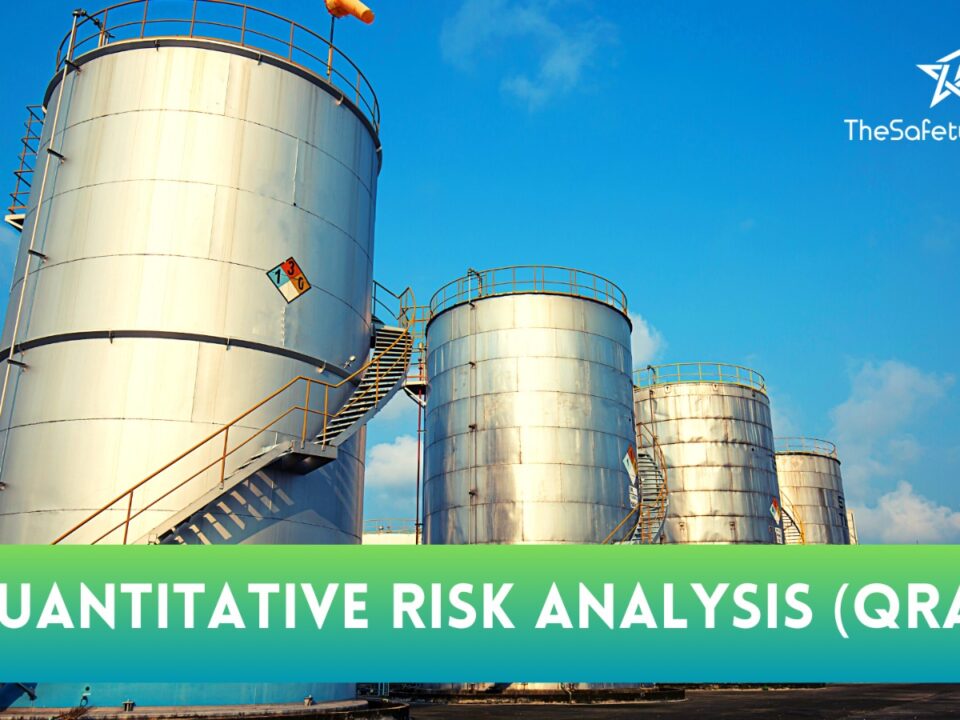Mitigating Operational Risks in India’s Process Industries: The Power of Quantitative Risk Analysis

The Ultimate Guide to Implementing an Effective Safety Management System: A Step-by-Step Approach
October 7, 2023
Understanding Hazardous Area Classification for Gas Filling Plants in India: Ensuring Safety Compliance to Protect Workers and the Environment
October 9, 2023In this article, we delve into the world of India’s process industries and the critical need for mitigating operational risks. From chemical plants to manufacturing facilities, these sectors are constantly exposed to a myriad of challenges that can disrupt operations and compromise safety. To combat these risks effectively, we explore the power of quantitative risk analysis – a powerful tool that allows organizations to assess and prioritize potential hazards based on data-driven insights. Join us as we unravel the key principles behind this approach, offering you a comprehensive understanding of how quantitative risk analysis can revolutionize the way India’s process industries tackle operational risks head-on. Get ready to unlock a new era of safety and efficiency. So keep reading and discover the power that awaits you.
Introduction
India’s process industries play a vital role in driving the nation’s economy, but they are not without their fair share of risks. Operational risks, in particular, pose significant challenges to the smooth functioning of these industries. From unforeseen equipment failures and supply chain disruptions to safety incidents and environmental hazards, operational risks can lead to severe financial losses as well as reputational damage. In this highly detailed article, we will delve into the world of mitigating operational risks in India’s process industries through the power of quantitative risk analysis. By employing this systematic approach, companies can not only identify potential risk events but also assess their probabilities and impact on business operations. By doing so, they gain valuable insights that help them make informed decisions when it comes to implementing robust risk mitigation strategies
Understanding Operational Risks in India’s Process Industries
India’s process industries play a crucial role in the country’s economic growth, encompassing sectors such as oil and gas, chemicals, pharmaceuticals, and manufacturing. However, these industries are inherently exposed to various operational risks that can significantly impact their performance and sustainability. Understanding these risks is paramount to implementing effective mitigation strategies. Operational risks in India’s process industries stem from a range of factors including equipment failures, supply chain disruptions, human error, regulatory non-compliance, natural disasters, and security breaches. These risks have the potential to cause production delays, environmental damage, financial losses, reputational harm, and even pose threats to human safety.
Moreover, the complexity of these industries amplifies the challenges associated with managing operational risks. With large-scale operations involving intricate processes and multiple stakeholders along the value chain – from raw material procurement to final product delivery – it becomes essential to have a comprehensive understanding of potential risk areas. By doing so, proactive measures can be implemented to minimize vulnerabilities and maximize resilience.
Successfully navigating operational risks in India’s process industries requires a holistic approach that combines industry knowledge with advanced risk management techniques. This article will delve into one such powerful technique: Quantitative Risk Analysis (QRA). By leveraging statistical models and data-driven insights, QRA enables industry players to identify high-impact risk events accurately and evaluate their potential consequences. Through this lens of quantification emerges an opportunity for improved decision-making processes that prioritize risk mitigation efforts effectively.
By proactively understanding operational risks in India’s process industries through robust analysis techniques like QRA opens up significant possibilities for optimizing operations while minimizing adverse outcomes. It empowers companies operating in these sectors to develop targeted strategies that improve safety standards for workers while safeguarding assets against potential disruptions or losses
Importance of Mitigating Operational Risks
Mitigating Operational Risks: Protecting India’s Process Industries – The importance of mitigating operational risks in India’s process industries cannot be overstated. With a rapidly growing economy and a thriving manufacturing sector, these industries play a crucial role in fueling the nation’s progress. However, they also face inherent risks that can disrupt operations, cause financial losses, and even jeopardize the safety of employees and surrounding communities.
By actively addressing operational risks through effective risk mitigation strategies, companies can not only protect their investments but also foster an environment conducive to sustainable growth. Mitigation efforts encompass identifying potential risk events, assessing their probabilities and impacts, evaluating risk exposure, and implementing proactive measures to minimize or eliminate those risks.
Furthermore, embracing quantitative risk analysis as a cornerstone of risk mitigation allows for informed decision-making based on data-driven insights. This systematic approach empowers industry leaders to prioritize key areas for improvement while allocating resources efficiently. By prioritizing the mitigation of operational risks, companies can instill confidence among stakeholders, enhance business resilience, and contribute to the overall stability and success of India’s process industries.
Overview of Quantitative Risk Analysis
Overview of Quantitative Risk Analysis:The realm of risk analysis provides a powerful framework for evaluating and addressing operational risks faced by India’s process industries. Within this framework, quantitative risk analysis emerges as a robust methodology that enables organizations to systematically measure, assess, and manage risks with a high degree of precision. By employing mathematical models and statistical techniques, quantitative risk analysis allows decision-makers to gain deeper insights into the probability of potential risk events occurring and their potential impacts on the business.
This approach brings about a paradigm shift in risk management by providing a structured and data-driven approach to decision-making. Rather than relying on gut feelings or qualitative assessments alone, quantitative risk analysis empowers organizations in India’s process industries to make informed choices based on tangible evidence. It allows them to quantify the likelihood of various scenarios unfolding and estimate the financial consequences associated with those scenarios.
Through quantitative risk analysis, organizations can identify critical areas where they are most vulnerable, enabling them to prioritize resources and design effective mitigating strategies. This method fosters an environment of proactive risk management that not only safeguards against potential losses but also cultivates a culture of continuous improvement within the industry as a whole. By embracing this analytical approach, India’s process industries can enhance their resilience while stimulating innovation and growth for years to come.
Key Steps in Conducting Quantitative Risk Analysis for Operational Risks
Key Steps in Conducting Quantitative Risk Analysis for Operational Risks: Collecting Relevant Data for Analysis:
In order to effectively mitigate operational risks, it is crucial to gather and analyze relevant data. This involves collecting information on past incidents, near-misses, and historical data related to the process industries in India. By systematically organizing this data, valuable insights can be gleaned to identify patterns, trends, and potential risk events. Furthermore, obtaining accurate and comprehensive data allows for a more robust analysis and enhances the accuracy of risk assessments.
Identifying and Assessing Potential Risk Events:
Once the necessary data is collected, the next step is to identify potential risk events that could impact operational processes. This requires a systematic approach that involves engaging key stakeholders across various departments of an organization such as operations, maintenance, health and safety, and environmental management. Through brainstorming sessions or structured workshops, these stakeholders can collectively identify all possible risk events that could occur within their respective areas of expertise.
Assessing Probabilities and Impact of Risk Events:
After identifying potential risk events, it is essential to assess their probabilities of occurrence as well as their potential impact on operations. A quantitative approach can be adopted by assigning probability values based on historical data or expert judgment. Similarly, impact assessments can be carried out by evaluating potential consequences such as production loss, financial implications, reputational damage, or harm to personnel or the environment. By quantifying these probabilities and impacts using reliable methodologies like Monte Carlo simulations or fault tree analysis, organizations gain a deeper understanding of the magnitude of each identified risk event.
Evaluating Risk Exposure and Potential Losses:
Once probabilities and impacts are assessed for each identified risk event separately; an overall evaluation of an organization’s total risk exposure can be conducted
Collecting Relevant Data for Analysis
Collecting Relevant Data for Analysis:In the pursuit of mitigating operational risks in India’s process industries, the initial step is to collect relevant data for analysis. This crucial phase lays the groundwork for a comprehensive and accurate risk assessment. One must cast a wide net to gather all pertinent information from various sources, including historical data, industry reports, incident databases, and expert opinions.
The collection process requires meticulous attention to detail as it sets the stage for subsequent risk analysis. It involves identifying key variables that influence operational risks such as equipment failure rates, maintenance schedules, process deviations, safety incidents, and external factors like weather patterns or market fluctuations. The aim is to establish a robust dataset that encompasses both quantitative and qualitative information.
It is essential to approach data collection with enthusiasm and optimism as each piece contributes to building a holistic understanding of operational risks faced by India’s process industries. By ensuring thoroughness and accuracy in this phase, organizations can gain valuable insights that pave the way for effective risk mitigation strategies. The comprehensive data collected forms the foundation upon which informed decisions can be made to protect employees’ well-being and enhance business performance.
Identifying and Assessing Potential Risk Events
Identifying and Assessing Potential Risk Events:With an intricate understanding of operational risks, India’s process industries can proactively mitigate potential threats by identifying and assessing risk events. This involves a comprehensive examination of all conceivable scenarios that could jeopardize the smooth functioning of industrial operations. By conducting an exhaustive analysis, organizations can unearth hidden vulnerabilities and anticipate potential disruptions before they materialize.
The process begins by examining internal processes, such as equipment failures, human error, or supply chain interruptions. Additionally, external factors like natural disasters or regulatory changes are carefully evaluated. This meticulous assessment not only sensitizes stakeholders to the diverse range of possible risks but also allows for a deeper understanding of their interdependencies. By adopting such a holistic approach, organizations gain valuable insights that enable them to develop robust risk mitigation strategies tailored to their specific needs.
Creative Content: Just as skilled detectives tirelessly chase clues to unravel mysteries, professionals in India’s process industries meticulously seek out potential risk events lurking in the shadows. By delving into every nook and cranny of their operations, they shine a light on vulnerabilities and embrace the power of foresight. Their unwavering commitment ensures that risks are not merely addressed reactively but instead pre-empted with conviction.
Optimistic Spin: The process of identifying and assessing potential risk events empowers India’s process industries with knowledge that becomes their shield against adversities. By embracing this proactive mindset and developing a keen eye for detecting risks from various angles, these industries are well-equipped to navigate challenges smoothly while embracing opportunities for growth with unwavering confidence.
Assessing Probabilities and Impact of Risk Events
Assessing Probabilities and Impact of Risk Events:Within the realm of quantitative risk analysis, assessing the probabilities and impact of risk events plays a crucial role in understanding the potential consequences that can arise from operational risks in India’s process industries. It involves a meticulous examination of past data, employing statistical models, and expert judgment to estimate the likelihood of each identified risk event occurring, as well as its potential impact on various aspects of operations.
By employing sophisticated analytical techniques such as Monte Carlo simulations, decision trees, and sensitivity analyses, organizations can gain invaluable insights into the possible outcomes associated with different risk events. This allows decision-makers to prioritize their mitigation efforts effectively. Furthermore, exploring various scenarios enables firms to identify critical areas where investment in preventative measures can yield maximum results.
It is important to note that assessing probabilities and impact should not be viewed solely through a pessimistic lens. Instead, it presents an opportunity for organizations to proactively address vulnerabilities within their operations and implement robust risk management strategies. The aim is not only to mitigate potential losses but also to optimize overall business performance by reducing uncertainties and enhancing resilience in the face of adversities.
Evaluating Risk Exposure and Potential Losses
Evaluating Risk Exposure and Potential Losses: Within India’s process industries, evaluating risk exposure and potential losses is a critical step in effectively mitigating operational risks. This entails a comprehensive analysis of the various risk scenarios identified earlier, taking into account their probabilities and potential impacts. By quantifying these factors, organizations can gain valuable insights into the financial consequences that may arise from different risk events.
One thought-provoking aspect of this evaluation is recognizing the interconnectedness between risks and their potential cascading effects. By simulating different scenarios, decision-makers can understand how a single risk event might trigger a series of subsequent events, amplifying losses. This holistic assessment allows for more accurate estimations of overall risk exposure.
The optimistic spin here lies in the power of foresight that quantitative risk analysis provides. Armed with this knowledge, organizations can proactively develop strategies to minimize potential losses and enhance their resilience against unforeseen circumstances. Moreover, by identifying high-risk areas or processes through rigorous evaluation, companies can allocate resources effectively to mitigate those risks pre-emptively. Ultimately, this proactive approach reinforces confidence in India’s process industries’ ability to navigate challenges while maintaining long-term growth and sustainability.
Implementing Risk Mitigation Strategies
Implementing Risk Mitigation Strategies:
Within the context of operational risks in India’s process industries, implementing effective risk mitigation strategies is crucial to ensure the continued success and sustainability of these industries. By employing a proactive approach to risk management, organizations can not only minimize potential losses but also enhance their overall operational efficiency. One key strategy for risk mitigation is the development and implementation of robust safety protocols and procedures. This entails conducting thorough risk assessments to identify potential hazards, ensuring compliance with relevant safety regulations, and providing comprehensive training to employees. By fostering a culture of safety-consciousness and equipping staff with the necessary knowledge and skills, organizations can significantly reduce the likelihood of accidents or incidents that may disrupt operations.
Another effective strategy is diversifying supply chains and adopting redundancy measures. In an era where disruptions due to natural disasters or geopolitical events are becoming increasingly common, having alternative suppliers or backup facilities can safeguard against sudden disruptions in critical inputs or production capabilities. Building relationships with multiple suppliers not only enhances resilience but also fosters healthy competition, ultimately benefiting both the organization and its stakeholders.
Furthermore, leveraging advanced technologies such as predictive analytics and real-time monitoring systems can bolster risk mitigation efforts. By utilizing data-driven insights to identify potential vulnerabilities or deviations from normal operating conditions, organizations can take proactive measures to address emerging risks before they escalate into significant issues. Embracing technology-driven solutions empowers businesses with greater control over their operations while streamlining processes for enhanced productivity.
In conclusion, implementing robust risk mitigation strategies allows India’s process industries to navigate operational risks effectively while maintaining their competitive edge. By prioritizing safety measures, diversifying supply chains, and embracing technological advancements, organizations can proactively mitigate risks while optimizing their overall operational performance
Monitoring and Reviewing Risk Mitigation Efforts
The process of monitoring and reviewing risk mitigation efforts is paramount in ensuring the effectiveness of risk management strategies in India’s process industries. By establishing a robust system for continuous assessment, organizations can proactively identify any deviations or weaknesses in their risk mitigation plans. One essential aspect of monitoring is the regular analysis and interpretation of key performance indicators (KPIs) that are relevant to operational risks. These KPIs may include metrics such as incident frequency, severity, and response time. By tracking these indicators over time, organizations can gain valuable insights into the success of their risk mitigation efforts.
Furthermore, conducting periodic audits and inspections plays a crucial role in evaluating the implementation and adherence to risk mitigation strategies. These assessments help identify areas where improvement is needed, allowing organizations to take corrective actions promptly. Additionally, involving internal and external stakeholders in the monitoring process fosters transparency and accountability while promoting a culture of continuous improvement.
By diligently monitoring and reviewing risk mitigation efforts, India’s process industries can foster a proactive approach to operational risks. This ongoing commitment not only ensures the effectiveness of implemented strategies but also provides an opportunity for organizations to learn from past experiences and adapt their approaches accordingly. Ultimately, this dedication contributes to creating safe working environments that mitigate potential risks while fostering sustainable growth within these industries.
Case Studies: Successful Applications of Quantitative Risk Analysis in India’s Process Industries
In the bustling world of India’s process industries, several successful case studies exemplify the transformative power of quantitative risk analysis in mitigating operational risks. One such example is the case of a leading petrochemical company that used quantitative risk analysis to evaluate potential hazards in their manufacturing plant. By employing advanced statistical modeling techniques and data-driven simulations, they were able to identify critical areas for improvement and implement targeted risk mitigation strategies. The result was not only a significant reduction in accidents and downtime but also an overall enhancement in operational efficiency, bolstering the company’s reputation as a safe and reliable industry leader. Another remarkable instance involves a prominent pharmaceutical company that harnessed the potential of quantitative risk analysis to navigate complex regulatory environments. By analyzing various risk factors, including compliance issues, supply chain disruptions, and quality control challenges, they were able to proactively address potential vulnerabilities. This proactive approach not only ensured uninterrupted production but also enabled them to maintain high standards of product quality. As a result, the company successfully expanded its market share and solidified its position as an industry frontrunner.
These case studies serve as powerful illustrations of how embracing quantitative risk analysis empowers organizations operating in India’s process industries to achieve tangible improvements in safety standards, operational efficiency, and profitability. By leveraging data-driven insights and adopting proactive risk management strategies, companies can not only safeguard their operations but also gain a competitive edge within this dynamic sector.
Benefits and Challenges of Using Quantitative Risk Analysis
Benefits and Challenges of Using Quantitative Risk Analysis: Quantitative risk analysis offers numerous benefits to India’s process industries in mitigating operational risks. Firstly, it allows for a comprehensive and systematic evaluation of potential risks, enabling organizations to prioritize their resources effectively. By quantifying the probabilities and impact of risk events, decision-makers can gain a clearer understanding of the potential losses, thereby facilitating more informed risk mitigation strategies.
Furthermore, quantitative risk analysis provides a robust framework for evaluating the effectiveness of existing control measures and identifying areas for improvement. This ensures that resources are allocated where they are most needed, thereby enhancing operational efficiency and reducing financial losses. Moreover, by incorporating data-driven insights into decision-making processes, organizations can bolster their ability to make sound strategic choices with confidence.
However, employing quantitative risk analysis also presents its fair share of challenges. One major hurdle is the availability and quality of data required for accurate analysis. Obtaining reliable historical data on past incidents can be challenging in India’s process industries due to limited reporting mechanisms or confidentiality concerns. Additionally, accurately estimating probabilities and impacts may prove difficult given the dynamic nature of operational risks.
Despite these challenges, embracing quantitative risk analysis empowers India’s process industries to proactively manage risks with precision. Through collaboration between industry stakeholders and regulators to improve data collection mechanisms and sharing practices, these challenges can be overcome. The future holds immense potential for leveraging advanced analytics and machine learning techniques in quantitative risk analysis to further enhance its effectiveness in safeguarding operations across diverse sectors within India’s vibrant industrial landscape.
Conclusion
In conclusion, the power of quantitative risk analysis in mitigating operational risks in India’s process industries cannot be overstated. By adopting a systematic and data-driven approach, organizations can effectively identify, assess, and manage potential risks. This enables them to make informed decisions, allocate resources efficiently, and ultimately enhance their overall operational resilience. Embracing this proactive mindset and leveraging the insights gained from quantitative risk analysis will empower Indian process industries to navigate challenges with confidence, drive sustainable growth, and secure a prosperous future for all stakeholders involved. The path to success lies in recognizing that risk analysis is not merely a burden but rather an opportunity for continuous improvement and innovation.




